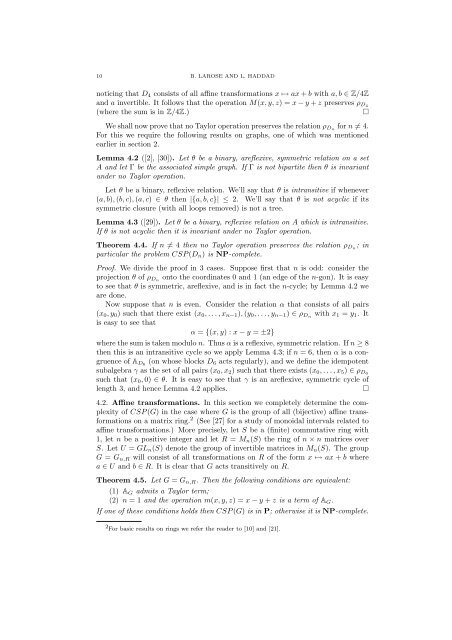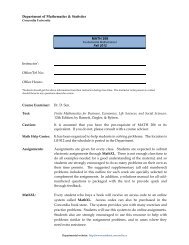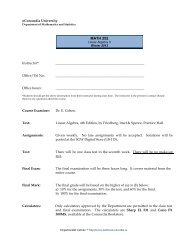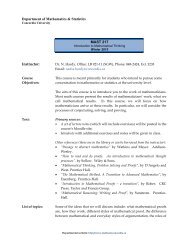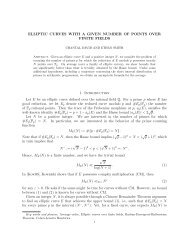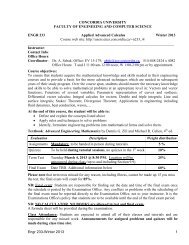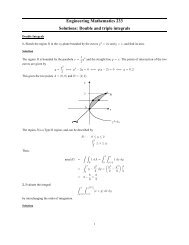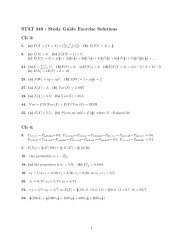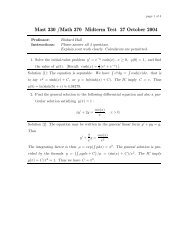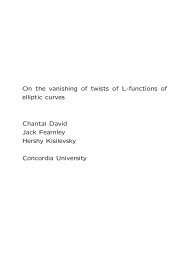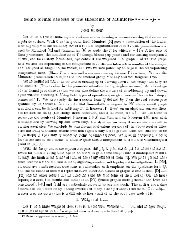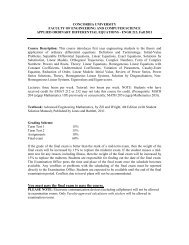COLOURINGS OF HYPERGRAPHS, PERMUTATION GROUPS ...
COLOURINGS OF HYPERGRAPHS, PERMUTATION GROUPS ...
COLOURINGS OF HYPERGRAPHS, PERMUTATION GROUPS ...
You also want an ePaper? Increase the reach of your titles
YUMPU automatically turns print PDFs into web optimized ePapers that Google loves.
10 B. LAROSE AND L. HADDAD<br />
noticing that D 4 consists of all affine transformations x ↦→ ax + b with a, b ∈ Z/4Z<br />
and a invertible. It follows that the operation M(x, y, z) = x − y + z preserves ρ D4<br />
(where the sum is in Z/4Z.)<br />
□<br />
We shall now prove that no Taylor operation preserves the relation ρ Dn for n ≠ 4.<br />
For this we require the following results on graphs, one of which was mentioned<br />
earlier in section 2.<br />
Lemma 4.2 ([2], [30]). Let θ be a binary, areflexive, symmetric relation on a set<br />
A and let Γ be the associated simple graph. If Γ is not bipartite then θ is invariant<br />
under no Taylor operation.<br />
Let θ be a binary, reflexive relation. We’ll say that θ is intransitive if whenever<br />
(a, b), (b, c), (a, c) ∈ θ then |{a, b, c}| ≤ 2. We’ll say that θ is not acyclic if its<br />
symmetric closure (with all loops removed) is not a tree.<br />
Lemma 4.3 ([29]). Let θ be a binary, reflexive relation on A which is intransitive.<br />
If θ is not acyclic then it is invariant under no Taylor operation.<br />
Theorem 4.4. If n ≠ 4 then no Taylor operation preserves the relation ρ Dn ; in<br />
particular the problem CSP (D n ) is NP-complete.<br />
Proof. We divide the proof in 3 cases. Suppose first that n is odd: consider the<br />
projection θ of ρ Dn onto the coordinates 0 and 1 (an edge of the n-gon). It is easy<br />
to see that θ is symmetric, areflexive, and is in fact the n-cycle; by Lemma 4.2 we<br />
are done.<br />
Now suppose that n is even. Consider the relation α that consists of all pairs<br />
(x 0 , y 0 ) such that there exist (x 0 , . . . , x n−1 ), (y 0 , . . . , y n−1 ) ∈ ρ Dn with x 1 = y 1 . It<br />
is easy to see that<br />
α = {(x, y) : x − y = ±2}<br />
where the sum is taken modulo n. Thus α is a reflexive, symmetric relation. If n ≥ 8<br />
then this is an intransitive cycle so we apply Lemma 4.3; if n = 6, then α is a congruence<br />
of A D6 (on whose blocks D 6 acts regularly), and we define the idempotent<br />
subalgebra γ as the set of all pairs (x 0 , x 2 ) such that there exists (x 0 , . . . , x 5 ) ∈ ρ D6<br />
such that (x 0 , 0) ∈ θ. It is easy to see that γ is an areflexive, symmetric cycle of<br />
length 3, and hence Lemma 4.2 applies.<br />
□<br />
4.2. Affine transformations. In this section we completely determine the complexity<br />
of CSP (G) in the case where G is the group of all (bijective) affine transformations<br />
on a matrix ring. 2 (See [27] for a study of monoidal intervals related to<br />
affine transformations.) More precisely, let S be a (finite) commutative ring with<br />
1, let n be a positive integer and let R = M n (S) the ring of n × n matrices over<br />
S. Let U = GL n (S) denote the group of invertible matrices in M n (S). The group<br />
G = G n,R will consist of all transformations on R of the form x ↦→ ax + b where<br />
a ∈ U and b ∈ R. It is clear that G acts transitively on R.<br />
Theorem 4.5. Let G = G n,R . Then the following conditions are equivalent:<br />
(1) A G admits a Taylor term;<br />
(2) n = 1 and the operation m(x, y, z) = x − y + z is a term of A G .<br />
If one of these conditions holds then CSP (G) is in P; otherwise it is NP-complete.<br />
2 For basic results on rings we refer the reader to [10] and [21].


